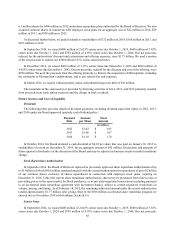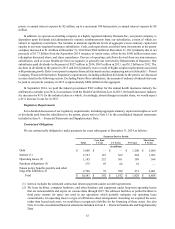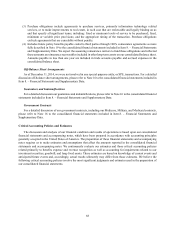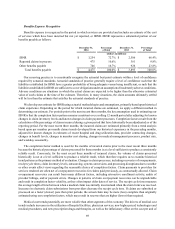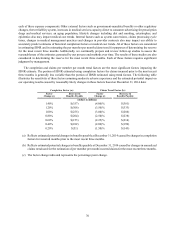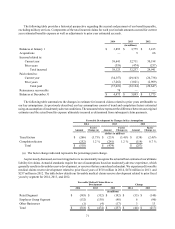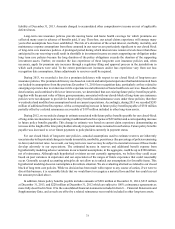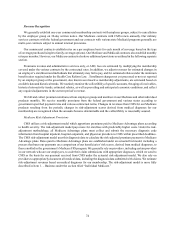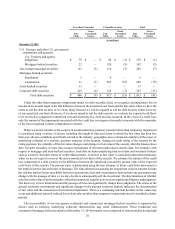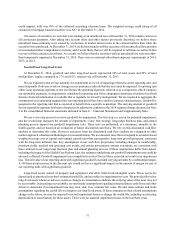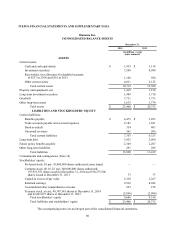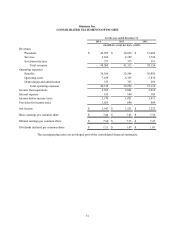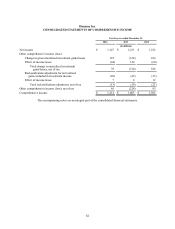Humana 2014 Annual Report Download - page 82
Download and view the complete annual report
Please find page 82 of the 2014 Humana annual report below. You can navigate through the pages in the report by either clicking on the pages listed below, or by using the keyword search tool below to find specific information within the annual report.74
Revenue Recognition
We generally establish one-year commercial membership contracts with employer groups, subject to cancellation
by the employer group on 30-day written notice. Our Medicare contracts with CMS renew annually. Our military
services contracts with the federal government and our contracts with various state Medicaid programs generally are
multi-year contracts subject to annual renewal provisions.
Our commercial contracts establish rates on a per employee basis for each month of coverage based on the type
of coverage purchased (single to family coverage options). Our Medicare and Medicaid contracts also establish monthly
rates per member. However, our Medicare contracts also have additional provisions as outlined in the following separate
section.
Premiums revenue and administrative services only, or ASO, fees are estimated by multiplying the membership
covered under the various contracts by the contractual rates. In addition, we adjust revenues for estimated changes in
an employer’s enrollment and individuals that ultimately may fail to pay, and for estimated rebates under the minimum
benefit ratios required under the Health Care Reform Law. . Enrollment changes not yet processed or not yet reported
by an employer group or the government, also known as retroactive membership adjustments, are estimated based on
available data and historical trends. We routinely monitor the collectibility of specific accounts, the aging of receivables,
historical retroactivity trends, estimated rebates, as well as prevailing and anticipated economic conditions, and reflect
any required adjustments in the current period’s revenue.
We bill and collect premium remittances from employer groups and members in our Medicare and other individual
products monthly. We receive monthly premiums from the federal government and various states according to
government specified payment rates and various contractual terms. Changes in revenues from CMS for our Medicare
products resulting from the periodic changes in risk-adjustment scores derived from medical diagnoses for our
membership are recognized when the amounts become determinable and the collectibility is reasonably assured.
Medicare Risk-Adjustment Provisions
CMS utilizes a risk-adjustment model which apportions premiums paid to Medicare Advantage plans according
to health severity. The risk-adjustment model pays more for enrollees with predictably higher costs. Under the risk-
adjustment methodology, all Medicare Advantage plans must collect and submit the necessary diagnosis code
information from hospital inpatient, hospital outpatient, and physician providers to CMS within prescribed deadlines.
The CMS risk-adjustment model uses this diagnosis data to calculate the risk-adjusted premium payment to Medicare
Advantage plans. Rates paid to Medicare Advantage plans are established under an actuarial bid model, including a
process that bases our payments on a comparison of our beneficiaries’ risk scores, derived from medical diagnoses, to
those enrolled in the government’s Medicare FFS program. We generally rely on providers, including certain providers
in our network who are our employees, to code their claim submissions with appropriate diagnoses, which we send to
CMS as the basis for our payment received from CMS under the actuarial risk-adjustment model. We also rely on
providers to appropriately document all medical data, including the diagnosis data submitted with claims. We estimate
risk-adjustment revenues based on medical diagnoses for our membership. The risk-adjustment model is more fully
described in Item 1. – Business under the section titled “Individual Medicare.”



